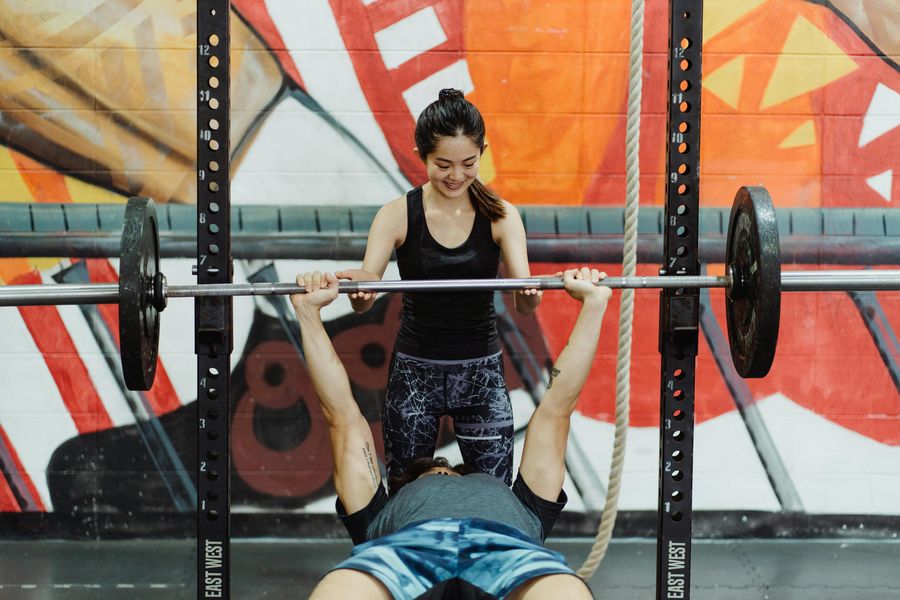Female-to-Female Attraction Signs: Navigating Relationships and Friendships
Have you ever found yourself wondering if your female friend is attracted to you, or if you’re just reading too much into her behavior? It’s not always easy to determine the difference between attraction and friendship, especially when the lines between the two can be blurry.
In this article, we’ll explore some common signs of female-to-female attraction, how to differentiate between attraction and friendship, and offer some advice on how to navigate these complex relationships.
Deep Eye Contact: The Windows to the Soul
The way someone looks at you can be a telltale sign of attraction.
Deep eye contact is a well-known indicator that someone is interested in you. If your female friend frequently holds eye contact with you, especially if it’s longer than usual, that could be a sign that she’s feeling attracted to you.
Eye contact is essential for building trust and intimacy, so don’t shy away from it if you’re feeling the same way.
Physical Touch: A Sign of Affection
Another way to tell if your female friend is attracted to you is by how often she touches you.
Physical touch is a powerful means of communication that can indicate affection, attraction, or even love. If your friend is touching your arm, hugging you, or sitting close to you, those could be signs that she’s interested in more than just a friendship.
Body Position: An Indicator of Attraction
How someone positions their body can give insight into how they feel about you. If your female friend is always facing you, leaning towards you, or mirroring your movements, she might be interested in more than just friendship.
These subtle cues can be picked up by someone who’s paying attention, so keep an eye out for any changes in your friend’s body language.
Coming Out to You: Trust and Respect
If your female friend comes out to you as LGBTQ, it’s a sign that she trusts and respects you enough to share a personal aspect of her life.
It could also be a sign that she’s interested in pursuing a romantic relationship with you. Coming out is never easy, so be kind and supportive of your friend’s bravery and honesty.
Looking for Excuses to Reach Out: Communication is Key
If your female friend is always finding excuses to reach out to you, whether it’s through texting, calling, or social media, she might be trying to build a deeper connection with you. Communication is key in any relationship, so if your friend is making an effort to stay in touch, that’s a good sign that she values your friendship and wants to take things to the next level.
Jealousy: A Sign of Competition
Jealousy is a complex emotion that can be a sign of attraction or just competition. If your female friend gets jealous when you talk about other people or spend time with someone else, it could be a sign that she’s interested in you romantically.
However, jealousy can also be a sign of insecurity or possessiveness, so be careful not to mistake it for attraction.
Interested in Your Love Life: Curiosity or Attraction?
If your female friend is always asking about your relationship history or your current dating situation, it could be a sign that she’s interested in more than just friendship. However, it’s also possible that she’s just curious or seeking advice.
Clarify her intentions by asking her directly if she’s interested in pursuing a romantic relationship with you.
Flirting and Teasing: A Clear Sign of Attraction
Flirting and teasing are clear signs of attraction.
If your female friend is constantly making sexual jokes or flirting with you, it’s a clear indication that she’s interested in you romantically. However, be sure to establish clear boundaries and consent before taking things to the next level.
Nervousness: Shyness or Attraction?
If your female friend is nervous around you, it could be a sign of shyness or attraction.
Some people get nervous when they’re around someone they’re attracted to. If you notice that your friend is fidgeting or avoiding eye contact when she’s with you, it could be a sign that she’s interested in you romantically.
Trust: A Key Component of Any Relationship
Trust is a key component of any healthy relationship. If your female friend trusts you with personal information or secrets, that’s a sign that she values your relationship and sees you as a confidante.
Trust is essential for building intimacy and emotional connection, so be sure to nurture that trust by being honest and reliable.
Listening: Attentiveness and Compassion
If your female friend listens to you attentively and shows compassion when you talk about your feelings, it could be a sign that she’s interested in more than just friendship.
Being a good listener is a critical skill for building emotional connections, so if your friend is always there to listen to you, that’s a good sign that she values your relationship.
Remembering Little Things: Attention to Detail
If your female friend remembers little things about you, like your favorite food or your birthday, it could be a sign that she’s interested in you romantically.
Attention to detail is a key indicator of someone who’s invested in a relationship, so be sure to reciprocate by showing interest in her life as well.
Paying You Compliments: Praise and Admiration
If your female friend is always paying you compliments, that could be a sign that she’s interested in you romantically.
Compliments are a way to show admiration and affection, so if your friend is telling you how beautiful or smart you are, that’s a clear signal of attraction.
Romantic Surprises: A Clear Indicator of Attraction
If your female friend is constantly surprising you with romantic gestures, like buying you flowers or planning a special date, that’s a clear sign that she’s interested in you romantically.
Romantic surprises are a way to show love and affection, so be sure to reciprocate if you’re feeling the same way.
Female-to-Female Attraction and Friendship: Navigating Complex Relationships
Navigating the complex landscape of female-to-female attraction and friendship can be challenging, but with the right communication and trust, it’s possible to build healthy, loving relationships.
It’s important to differentiate between attraction and friendship, establish clear boundaries and consent, and communicate openly and honestly with your friend. Remember that not every friendship needs to turn into a romantic relationship, and it’s okay to value your friend as a confidante and companion without taking things to the next level.
Ultimately, the most important thing is to respect each other’s feelings and build a relationship that’s authentic and fulfilling.
Female Body Language Signs: Decoding Nonverbal Communication
Body language is a crucial element of communication, and it reveals a lot about what someone is thinking and feeling.
In this section, we’ll explore some common female body language signs and what they mean.
Lip Movement: A Sign of Attraction
When a woman bites her lip, licks her lips, or purses them, it’s a sign that she’s feeling attracted to someone.
This behavior exposes her desire for intimacy or a sexual relationship. These subtle movements often indicate a desire for physical contact or a longing to be kissed, so if you’re interested in this woman, it could be an invitation to move things to the next level.
Laughing: A Sign of Happiness and Genuineness
Laughter is a powerful tool for building connections and emotional bonds. When a woman is genuinely happy, she’ll often laugh or smile readily.
This behavior is a clear indication that she’s comfortable in your presence and enjoys spending time with you. A genuine laugh is contagious, and if you notice yourself laughing more when you’re around her, it could be a sign that she’s interested in you romantically.
Preening: A Sign of Presentation and Self-Esteem
When a woman is interested in someone, she’ll often engage in preening behavior, like fixing her hair, clothing, or makeup. Preening is a way of presenting yourself in the best possible light and is often a sign of attraction.
When she takes care to present herself well around you, it’s a clear indication that she values your opinion and is interested in your response.
Hair Twirling: A Sign of Nervousness and Attraction
When a woman is feeling nervous around someone, she’ll often twirl her hair absentmindedly.
This behavior is a way of subtly releasing tension and redirecting it towards another focus. Additionally, hair twirling can also indicate attraction and a desire for physical touch.
If you notice this behavior from a female friend, it could be a sign that she’s interested in more than just friendship.
Chest and Hip Positioning: A Sign of Openness and Submissiveness
When a woman positions her chest and hips towards you, it’s a subconscious indication of attraction and openness to further interaction.
These stances are associated with greater comfort and trust. However, this type of body language can sometimes be unconscious, so don’t read too much into it without paying attention to other behavioral patterns.
LGBTQ Interactions: Honesty and Open Communication
LGBTQ (Lesbian, Gay, Bisexual, Transgender, Queer) identity is an essential aspect of who someone is, and it’s important to respect and support it. When it comes to building relationships with LGBTQ individuals, communication, and openness are key.
Here are some things to keep in mind when interacting with LGBTQ friends and acquaintances.
Coming Out to a Friend: A Sign of Trust and Honesty
When someone comes out as LGBTQ to you, it’s a sign that they trust you enough to reveal a personal aspect of their identity.
It can also mean that they’re interested in exploring a romantic relationship with you. It takes a lot of courage and vulnerability to come out to someone, so be kind, respectful, and supportive of their honesty and bravery.
LGBTQI+ Identification: A Way to Promote Self-Expression
Gender and sexual orientation are fluid identities, and everyone has unique experiences and preferences. When interacting with someone who identifies as LGBTQI+, it’s essential to be respectful, supportive, and open to their identity.
Many people use different terms to identify their gender and sexual orientation, so it’s important to know what they prefer and use those pronouns and terminology when referring to them. Supporting others expressing themselves authentically is key.
Clear Communication: The Foundation of Positive Relationships
Clear communication is critical in any relationship but is especially important when interacting with LGBTQ individuals. If you’re unsure about something, it’s always better to ask questions openly than make assumptions.
Good communication skills are essential when navigating the complex world of relationships and sexual orientation, so take the time to communicate authentically. Conversely, being on the receiving end of clear communication is also crucial, so make your intentions and preferences clear when interacting with LGBTQ friends.
Conclusion
Body language can be difficult to interpret, but by paying attention to subtle cues, you can learn a lot about what someone is feeling and thinking. When it comes to LGBTQ interactions, clear communication and respect are essential.
By being open, honest, and supportive, you can build strong, positive relationships with anyone, regardless of their sexual orientation or gender identity. Start to learn more about the different identities and start to understand how crucial communication and mutual respect are in building positive relationships.
Female-to-Female Friendship: Understanding the Friend Zone and Platonic Relationships
One of the most complex and debated topics in contemporary society is the idea of the friend zone. When friendship and romantic attraction intersect, navigating these interactions can be tricky.
In this section, we’ll explore the idea of the friend zone, examine female-to-female friendship, and analyze the different behaviors that define platonic relationships.
Trap of the Friend Zone: Is it Real?
The friend zone is a term used to describe a situation where one person is interested in pursuing a romantic relationship with someone else, but that person only sees them as a friend. In this scenario, the person who is interested in a romantic relationship is said to be “trapped” in the friend zone.
Although the concept of the friend zone has been the subject of debates in recent years, the reality is that everyone has experienced it at some point in their lives. In female-to-female relationships, the friend zone can be particularly difficult to navigate.
Due to societal norms around femininity and sexuality, it can be challenging for women to communicate their feelings openly without fear of judgment or rejection. It’s essential to recognize that although the friend zone can be frustrating, friendship should be valued and cherished for its unique qualities and contributions to a person’s life.
Female-Female Friendship: Building a Stronger Bond
Women often have stronger emotional connections with their female friends, making female-to-female friendships a unique and valuable bond. In female friendships, companionship and communication are key features that contribute to the development of deep and meaningful relationships.
For women, trust and vulnerability are crucial factors that help to create a positive and lasting friendship. However, female friendships can also be challenging to maintain due to societal norms around competitiveness, jealousy, and perfectionism.
By recognizing these factors and practicing open communication and empathy, women can create a space of support and mutual love in their friendships.
Friend-Like Behaviors: How to Determine a Platonic Relationship
Platonic relationships refer to relationships that are not romantic or sexual in nature.
Platonic relationships can exist between people of any gender or sexual orientation and can range from close friendships to casual acquaintanceships. However, it’s important to recognize the behaviors that define platonic relationships to avoid any miscommunication or confusion.
Some common friend-like behaviors include spending time together, engaging in conversation, and valuing each other’s opinions. When a relationship is platonic, physical touch is often non-existent or limited to hugs or casual hand-holding.
While it’s not uncommon for platonic relationships to include flirting or complimenting, if the interactions are not overtly sexual or suggestive, it’s likely that the relationship is purely platonic.
Individual Exploration: The Idea of Sexual Fluidity
Sexual fluidity is a term used to describe the idea that sexual orientation is not fixed and can change over time.
Though sexual fluidity may not be something that everyone experiences, it is a well-documented phenomenon that has gained more acceptance in recent years. Due to its increasingly recognized legitimacy, individuals are exploring their sexual identities more frequently and with greater acceptance.
For some individuals, this exploration may include exploring their sexual orientation or gender identity and experimenting with different types of relationships. When engaging in this type of exploration, it’s essential to communicate openly with others involved and to prioritize consent and mutual respect.
Sexual fluidity is a natural part of human expression, and by embracing and understanding ourselves and others better, we can create more inclusive and supportive communities.
Conclusion
Friendship, sexuality, and identity are complex topics with many nuances, and it’s important to recognize and respect these differences. By understanding the concepts of the friend zone, female-to-female friendship, platonic relationships, and sexual fluidity, individuals can build stronger and more positive connections with those around them.
Open communication, mutual respect, and empathy are essential pillars of any relationship, and it’s crucial to practice these qualities when exploring friendship or romantic relationships. Navigating these complex talks can be challenging, but with the right mindset and approach, anyone can build meaningful and positive connections with themselves and others.
In conclusion, understanding the nuances of relationships, identity, and behavior is crucial for building positive and meaningful connections with oneself and others. By recognizing the complexity of these topics, including the idea of the friend zone, female-to-female friendship, platonic relationships, and sexual fluidity, individuals can navigate their interactions intentionally, with empathy, and mutual respect.
Open communication, vulnerability, and mutual support are vital components of any relationship, and by practicing these qualities, we can create a world that is more inclusive, understanding, and accepting of everyone’s unique expression and identity.



